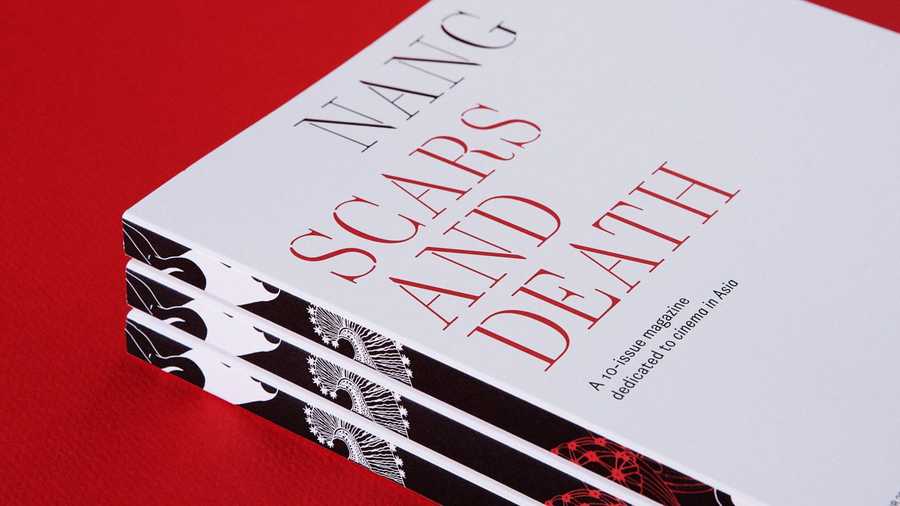
The World of Apu is a new multi-lingual, bimonthly online film magazine whose first issue appeared last November. The new second issue features Rafaella Britto on Satyajit Ray’s “most gloomy film,” The Goddess (1960), K Balamurugan on Shanjey Kumar Perumal’s Jagat (2015) and why it speaks to him personally, Maeve Rafferty on Brooklyn, the novel and John Crowley’s 2015 adaptation, Athiyan on another novel, Chemmeen, and Ramu Kariat’s 1965 adaptation, and more.
I want to focus on two interviews. The first is with Ben Slater, author of Kinda Hot: The Making of Saint Jack in Singapore. The topic at hand is 25: Histories and Memories of the Singapore International Film Festival, a collection that appeared in 2014.
The second interview is actually a two-parter, a conversation with Davide Cazzaro, the publisher and editor-of-chief of NANG, and another with Ben Slater again, here focusing on his involvement with this magnificently designed print publication dedicated to Asian cinema. There will be a total of ten issues, three of which are out; the fourth is in the works now. As Cazzaro explains, he concurs “with Peter Biľak, an editor and designer I respect a lot; in his editorial in the latest—and last—issue of Works That Work, he stated: ‘I believe we should be intentional about designing ends as well as beginnings.’” What’s more each issue—which comes, by the way, with its own specially designed bookmark—is a limited run of 1500 copies, and there will be no reprints.
Slater has guest-edited NANG 1: Screenwriting, with excerpts from screenplays such as Apichatpong Weerasethakul’s Tropical Malady (2004) and interviews with their writers conducted by Darcy Paquet, Oggs Cruz, and Sonia Kil, among others.
Beyond the reading, merely holding a copy of NANG, paging through it, is sheer pleasure. Cazzaro: “An obvious example of what I mean by ‘paper cinema’ is the Epilogue section of NANG 2: Scars and Death; if I may be permitted to say so without sounding pompous, I do believe we achieved something special in those eight pages.” Here, the guest editors are Yoo Un-Seong and John Torres. NANG 3: Fiction, guest-edited by writer and filmmaker Amir Muhammad (The Last Communist, 2006), opens with a gallery of posters—followed by an intermission before the storytelling begins.
MORE ISSUES
Over the past days and weeks, Catherine Grant has alerted us to four new issues of note. Let’s start with the launch of World Records Journal. “Published by UnionDocs Center for Documentary Art, World Records brings together the voices of scholars, critics, makers, and curators who offer new and complex perspectives on documentary to challenge and extend its margins.” In the inaugural issue:
- Editor Jason Fox opens the issue with the question, “What Do Cameras Do?”
- Ariella Azoulay writes about the cameras built by Israeli artist and philosopher Aïm Deüelle Lüski
- Ernest Larsen and Sherry Millner interview Isaac Julien
- Jeffrey Skoller considers the ways that phones and other portable cameras are “transforming the dynamics of the interactions between law enforcement officials and citizenry in the United States”
In the new issue of Film-Philosophy:
And there are three book reviews as well.
“For a Cosmopolitan Cinema” is the theme of the new, fourteenth issue of Alphaville. As editors James Mulvey, Laura Rascaroli, and Humberto Saldanha explain, the goal here is “to address cosmopolitanism in a way that considers and discusses the world from the vantage point of its many cultural locations and dynamics, thus escaping binarism, while at the same time focusing on the networks that are being developed today between the global and the local.”
- Daniela Berghahn “aims to critically reassess and, ultimately, rehabilitate exoticism” in her essays on Martin Butler and Bentley Dean’s Tanna (2015) and Ciro Guerra’s Embrace of the Serpent (2015)
- Relatedly, Maria Luna uses “the concept of ‘cosmopolitan cinematic margins’ to analyze the paradoxical meeting of the cosmopolitan meaning and discourses of Ciro Guerra’s Colombian films”
- Felicia Chan asks, “Why Are We Still Talking about Yellowface in Twenty-First-Century Cinema?”
- Sukhmani Khorana focuses on a Sudanese asylum seeker in Australia in Belinda Mason’s documentary Constance on the Edge (2016)
- Among the questions Dina Iordanova asks is: “What message does the multifaceted and multinational entertainment menu of global airlines convey in a political context that is defined by backlash against globalization and cosmopolitanism?”
- Dorota Ostrowska argues that the origins of the Cannes Film Festival “as a cosmopolitan event are found in the nineteenth- and early-twentieth-century cultural history of the French Riviera”
- Monia Acciari considers the “idea of film festivals as ‘cosmopolitan assemblage’”
- Anne Kustritz argues that Sherlock and Elementary “differ in their representations of the city in ways that bear significant political ramifications”
Alphaville 14 also features a dossier on “Teaching European Cinema” and three book reviews, including Gillian McIver’s on Maria Pramaggiore’s Making Time in Stanley Kubrick’s Barry Lyndon: Art History and Empire.
[in]Transition, the Journal of Videographic Film & Moving Image Studies in which creators of audiovisual essays present new work for review by their peers, opens its new issue with a special case. Kevin L. Ferguson has revised his essay “Lizard Train” in response to questions raised by reviewers Adam Hart and Tracy Cox-Stanton. Also:
Meantime, Another Gaze Journal, which has been publishing online since early 2016, is preparing its first print issue featuring “interviews with women including Carolee Schneemann, Mania Akbari, Laura Mulvey, Alice Diop, Bette Gordon, and Lis Rhodes. It contains pieces on the films of women including Kathleen Collins, Sally Potter, Chantal Akerman, Moyra Davey, Camille Henrot, Naomi Kawase, Germaine Dulac, Alice Guy-Blaché.”
For news and items of interest throughout the day, every day, follow @CriterionDaily.
from The Criterion Current http://ift.tt/2Ef3JGi
Nessun commento:
Posta un commento